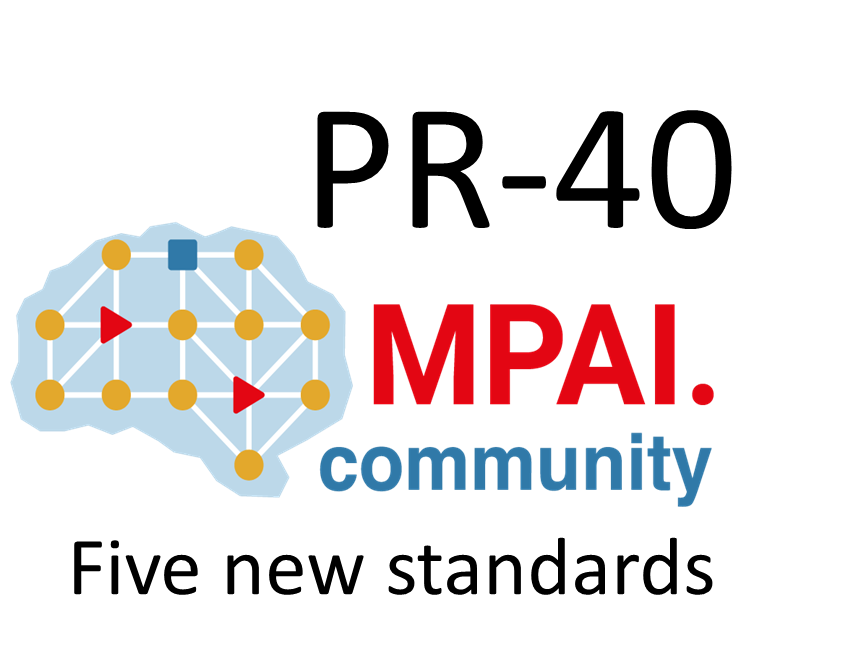Geneva, Switzerland – 24 January 2024. MPAI – Moving Picture, Audio and Data Coding by Artificial Intelligence – the international, non-profit, and unaffiliated organisation developing AI-based data coding standards has concluded its 40th General Assembly (MPAI-40) approving the publication of a range of standards covering disparate technologies and application domains.
Human and Machine Communication (MPAI-HMC) is a draft published for Community Comments, the last step before publication. It includes a wide range technologies available from existing MPAI standards to enable an Entity, i.e., a human or a machine, to hold a communication with Entities as humans do. Comments are due by 2024/02/19T23:59 UTC to secretariat@mpai.community.
The newly-approved Object and Scene Description (MPAI-OSD) V1.0 standard provides important technologies enabling the digital representation of position and orientation of Audio and Visual Objects and their combinations in Scenes. The MPAI-OSD capabilities enhance usability of the new Multimodal Conversation (MPAI-MMC) V2.1 and Portable Avatar Format (MPAI-PAF) V1.1.
MPAI Metaverse Model – Architecture (MPAI-MMM) V1.1 updates the MMM- Architecture Metadata to streamline communication between the Processes of a Metaverse Instance and uses the new MPAI-MMM Scripting Language (MMM-Script) to represent a wide range of use cases.
MPAI is now offering an innovative way to access to its new standards via the web:
MPAI-HMC: https://mpai.community/standards/mpai-hmc/mpai-hmc-specification/
MPAI-MMC: https://mpai.community/standards/mpai-mmc/mpai-mmc-specification/
MPAI-OSD: https://mpai.community/standards/mpai-osd/mpai-osd-specification/
MPAI-PAF: https://mpai.community/standards/mpai-paf/mpai-paf-specification/
MPAI is continuing its work plan that involving the following activities:
- AI Framework (MPAI-AIF): reference software, conformance testing, and application areas.
- AI for Health (MPAI-AIH): reference model and technologies for a system enabling clients to improve models processing health data and federated learning to share the training.
- Context-based Audio Enhancement (CAE-DC): new projects are brewing.
- Connected Autonomous Vehicle (MPAI-CAV): Functional Requirements of the data used by the MPIA-CAV – Architecture standard.
- Compression and Understanding of Industrial Data (MPAI-CUI): preparation for an extension to existing standard that includes support for more corporate risks.
- Human and Machine Communication (MPAI-HMC): model and technologies enabling a human or a machine to communicate with a machine or a human in a different cultural environment.
- Multimodal Conversation (MPAI-MMC): drafting reference software and conformance testing, and exploring new areas.
- MPAI Metaverse Model (MPAI-MMM): reference software and metaverse technologies requiring standards.
- Neural Network Watermarking (MPAI-NNW): reference software for enhanced applications.
- Portable Avatar Format (MPAI-PAF): reference software, conformance testing and new areas.
- End-to-End Video Coding (MPAI-EEV): video coding using AI-based End-to-End Video coding.
- AI-Enhanced Video Coding (MPAI-EVC). video coding with AI tools added to existing tools.
- Server-based Predictive Multiplayer Gaming (MPAI-SPG): technical report on mitigation of data loss and cheating.
- XR Venues (MPAI-XRV): development of the standard.
Legal entities and representatives of academic departments supporting the MPAI mission and able to contribute to the development of standards for the efficient use of data can become MPAI members.
Please visit the MPAI website, contact the MPAI secretariat for specific information, subscribe to the MPAI Newsletter and follow MPAI on social media: LinkedIn, Twitter, Facebook, Instagram, and YouTube.


